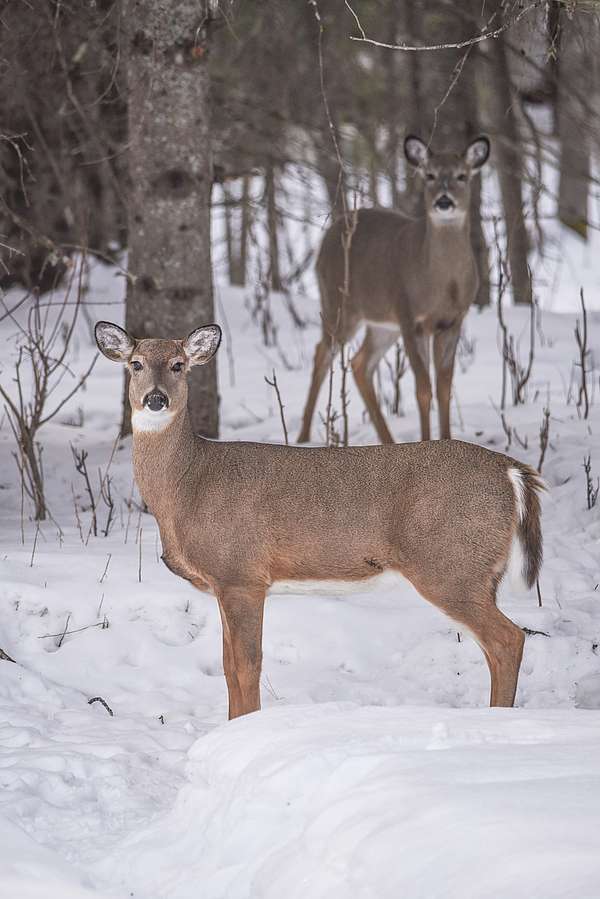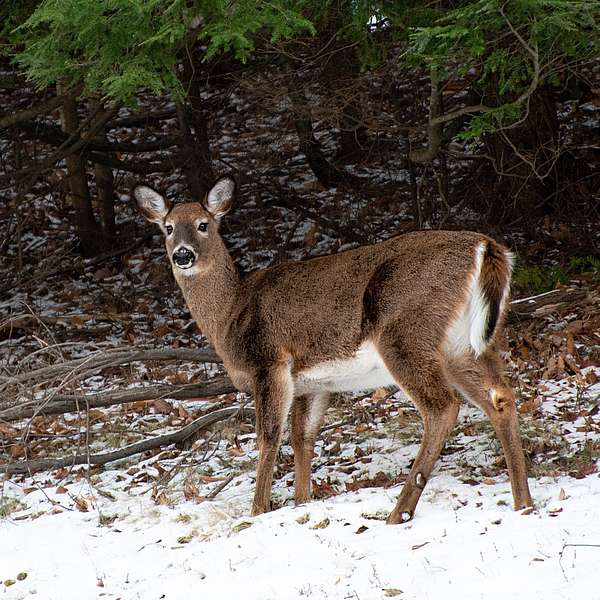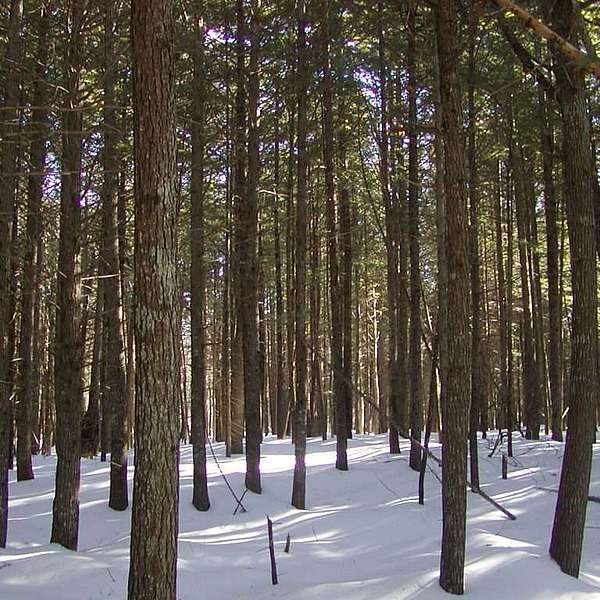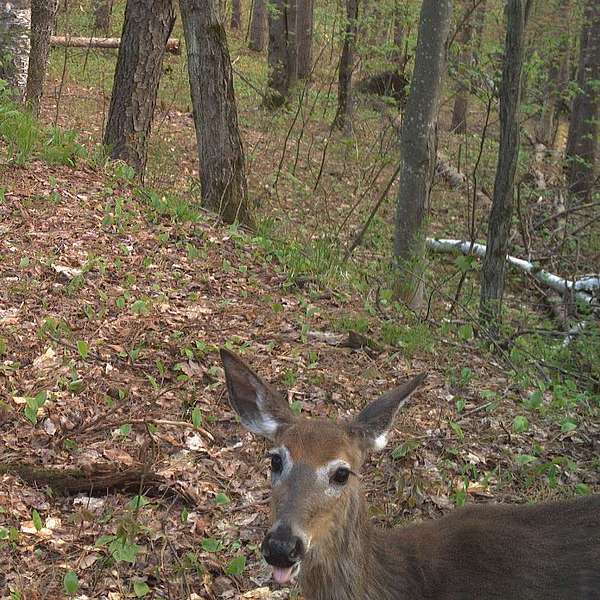by Nicole, AmeriCorps Lands & Trails Steward
At Stowe Land Trust conserved properties, I cannot help but notice the tracks, both old and fresh, that local creatures have imprinted on the January blanket of snow. Small bounding tracks with a center line made by a tail, surely from a mouse. An erratic line, wavy and coiling, is a good sign of a shrew. Across the ski trail, there are alternating heart-shaped tracks with sharp edges, indicating a white-tail deer must have just crossed here. White-tail deer (Odocoileus virginianus) are not ones to burrow in the ground or hibernate to survive the winter cold, so what are they doing? Where are these deer tracks headed? To find out, I spoke to Nick Fortin, a Vermont Fish and Wildlife Biologist, whose work focuses on maintaining a healthy deer population now and into the future.
Living on the Edge
Not surprisingly, winter is by far the most challenging time of year for deer in Vermont. Even considering recent mild winters, Vermont is near the northern limit of the species range for white-tail deer. In certain areas of Vermont, “deer are entirely limited by the severity and length of the winters,” said Fortin. As snowfall hits the region, deer consume poor-quality woody browse, and maneuvering in the snowpack requires more energy. The result: an overall loss of energy during the winter months. Luckily, white-tail deer are admirably adapted, both physically and behaviorally.
With a negative energy balance during the winter months, northern white-tail deer have an annual weight cycle that has been likened to sledding down a brushy hillside by ecologist William Mautz. The climb up the metaphorical hill starts in the fall, as deer build fat reserves by browsing specific plants that are high in protein and carbohydrates. The amount of body fat stored will determine how “high” the deer is able to climb, and the abundance of woody browse, or brush on the hillside, will slow the rate of fat depletion through the winter. Each deer gets just one sled ride each winter, with the goal of surviving to see spring.
Like other Vermont mammals, deer grow an insulating winter coat—one that has long hollow guard hairs and short underfur that allow for insulation even around zero °F and for the snow to sit on the fur without melting. Because deer in Vermont live near the northern limit of their range, they are reliant on concentrations of softwoods that provide a place with reduced snow depths, less wind, and slightly warmer temperatures compared to surrounding habitats during the winter. These “Deer Wintering Areas” or “Deer Yards” are also important havens for other animals during the long winter months. Fortin pointed out that one often overlooked winter food source for deer is “litterfall,” or the twigs that break off every time it snows. The mature conifers located in deer yards contribute to litterfall and are hosts for old man’s beard lichen to grow—a loved food resource for deer.
Under Pressure
Other times of the year, deer spread throughout the landscape.
According to Fortin, “In the winter, deer are forced, largely, to concentrate in certain areas where the snow isn’t as deep.” This results in a much higher concentration of deer in deer yards for several months. Fortin pointed out that even in areas where the overall density of deer is considered sustainable, there will still be “concentrated impacts in certain areas because of the seasonality of deer survival.” In fact, these deer “will have a severe impact on woody vegetation” in these areas, said Fortin.
An overabundance of deer can exacerbate these concentrated impacts by limiting the regeneration of native tree species, threatening endangered plant species, reducing hiding cover and forage for other wildlife, and reducing the abundance of ground-nesting birds. Over time, a large population of deer can alter forest plant communities and degrade the quality of habitat, both for themselves and other forest species.
Managing for Healthy Deer and Forests
How and what do managers monitor to measure the health of Vermont’s deer? Hunting data provides wildlife managers with parameters to examine population health, like body size, antler size, the presence of disease, and reproductive rates.
At the population level, Fortin noted that a healthy deer population involves “keeping deer in balance with their habitat so you can have a sustainable deer population.”
Historically, white-tail deer populations were kept in balance by predators like mountain lions and wolves, which have been absent from Vermont’s ecosystems since the late 1800s. With the loss of big cats and wolves, hunters now take on the role of the primary mechanism for maintaining an appropriate number of deer in the landscape.
Vermont deer hunting is managed by Wildlife Management Unit (WMU), each with an estimated number of how many deer each unit can support. Each year, the estimated deer population is compared to the state’s population objective set in the 2020-2030 Big Game Management Plan to inform management decisions. Per Vermont deer hunting regulations, a hunter can take up to four deer in a calendar year, one of which can be a legal buck (except for youth or novice hunters who may take an additional legal buck during the Youth and Novice seasons). In turn, deer populations are managed by adjusting the mortality rate of adult does. Department biologists, like Nick, must account for all non-hunting mortality of adult does based on winter severity, disease, and other factors. After considering non-hunting mortality and expected harvest during the archery, youth, and novice seasons, Vermont Fish and Wildlife will issue the appropriate number of antlerless deer permits during the muzzleloader season. As non-hunting mortality varies between years and between Wildlife Management Units, deer hunting regulations also change annually, particularly in management units open to antlerless archery and muzzleloader permits.
Maintaining deer health and forest health go hand in hand. As Vermont weather becomes more unpredictable, it is vital that forest management activities maintain high-quality deer yards for deer winter survival. By collaborating with hunters, Vermont Fish and Wildlife biologists can work to maintain a deer population that is in balance with surrounding habitats.
“Hunting is not only a great recreational opportunity but a great management tool, and we need more people to do it.”



